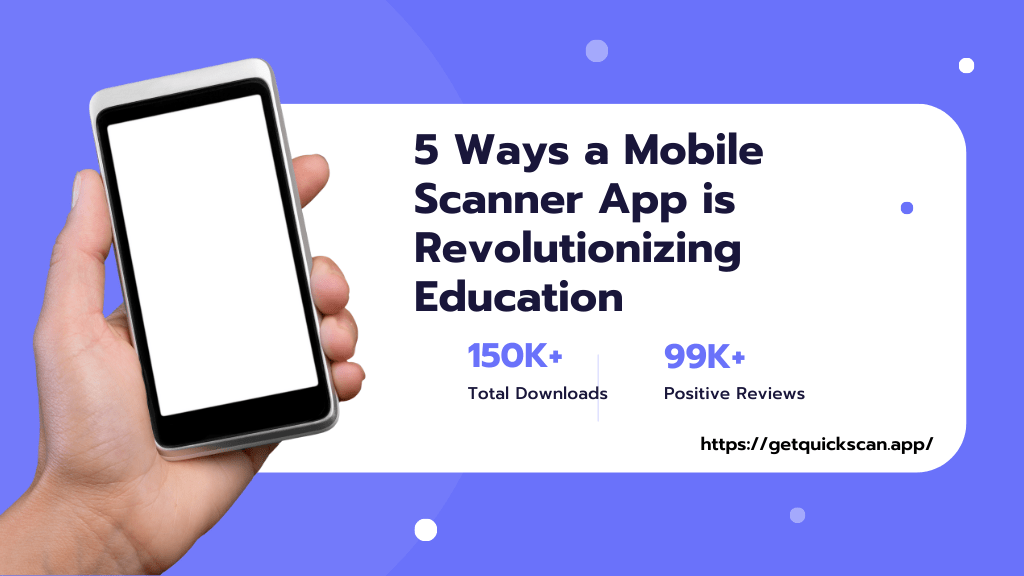Introduction
Mobile scanner apps have been a game-changer for educators and students alike. For years, scanning documents required bulky scanners and dedicated computer software, which made it cumbersome and time-consuming to digitize important materials. But with the advent of mobile scanner apps, users can now easily scan documents from their smartphones, making it much more convenient to capture and share information.

In this blog post, we will explore five ways in which mobile scanner apps are revolutionizing education:
Improved Accessibility
One of the most significant benefits of mobile scanner apps is that they improve accessibility to educational materials. Traditionally, educators had to rely on physical copies of texts, handouts, and other materials, which could be expensive, difficult to obtain, or even unavailable. With a mobile scanner app, educators and students can quickly and easily scan textbooks, articles, and other materials and store them digitally, making it easier to access and distribute these resources.
Furthermore, mobile scanner apps make it possible for students to scan handwritten notes and assignments, which can then be easily shared with classmates or teachers. This not only saves time but also ensures that students have a digital record of their work, which can be useful for revision purposes.
Streamlined Collaboration
Mobile scanner apps can also streamline collaboration among students and educators. For instance, when working on group projects, students can use mobile scanner apps to scan their handwritten or printed notes and share them with each other instantly. This makes it much easier to work together remotely, saving time and improving communication.
Similarly, educators can use mobile scanner apps to quickly scan student work and provide feedback electronically. This can help to speed up the grading process and ensure that students receive prompt and accurate feedback.
Mobile Scanner App has a significant role to play for the project management Tools to streamline our workflow and increase efficiency at the workplace.
Increased Efficiency
Mobile scanner apps can also improve efficiency in the classroom. By eliminating the need for physical copies of documents, mobile scanner apps can save time and reduce paper waste. Additionally, mobile scanner apps offer features like automatic cropping and image correction, which can help to improve the quality of scanned documents while saving time.
Moreover, mobile scanner apps can also be used to scan entire books or lengthy documents quickly. This feature can be particularly useful for educators who need to prepare research-based assignments or who want to provide students with additional reading materials.
Enhanced Flexibility
Mobile scanner apps offer a level of flexibility that traditional scanners simply cannot match. With a mobile scanner app installed on their smartphones, educators and students can scan documents from anywhere at any time, whether they are in class, at home, or on the move.
This flexibility means that educators can easily incorporate new resources into their lesson plans and adapt their teaching methods to meet the needs of individual students. Similarly, students can use mobile scanner apps to study and complete assignments on their own schedules, without having to rely on access to physical materials or computer software.
Improved Learning Outcomes
Finally, mobile scanner apps have the potential to improve learning outcomes by providing students with more engaging and interactive teaching materials. For instance, educators can use mobile scanner apps to scan images or diagrams from textbooks and create interactive quizzes or games that reinforce key concepts.
Similarly, students can use mobile scanner apps to scan notes or assignments and convert them into audio files or videos, making it easier to revise and absorb information. By providing students with multiple ways of engaging with educational materials, mobile scanner apps can help to improve retention and understanding of key concepts.
Related Article : Digitize Notes, Class Handouts & More With QuickScan Document Scan App
FAQ
Q: What are the uses of scanners in education?
A: Scanners have several uses in education, including:
- Digitizing physical copies of textbooks, articles, and other materials for easier access and distribution
- Scanning handwritten notes and assignments for digital storage and sharing with teachers or classmates
- Streamlining collaboration by allowing students to share scanned documents with each other and teachers
- Improving efficiency by eliminating the need for physical copies of documents and offering features like automatic cropping and image correction
- Providing flexibility by allowing educators and students to scan documents from anywhere at any time
- Enhancing learning outcomes by creating interactive quizzes or games that reinforce key concepts and converting notes into audio files or videos for easier revision and absorption of information.
Q: What is the benefit of a mobile scanner?
A: The benefit of a mobile scanner is that it allows you to easily scan documents, images, or other materials from your smartphone or tablet. This saves time and improves accessibility to important information by digitizing physical copies of documents. Mobile scanners also provide features like automatic cropping and image correction, making the scanning process more efficient and improving the quality of scanned documents.
Additionally, mobile scanners offer flexibility by allowing users to scan documents from anywhere at any time, making it easier to collaborate with others and adapt to changing needs. Overall, mobile scanners are a convenient tool for anyone who needs to scan and share information on-the-go.
Q: What is the purpose of an app scanner?
A: The purpose of an app scanner is to allow users to quickly and easily scan documents, images, or other materials using their smartphone or tablet. App scanners typically provide features like automatic cropping and image correction to improve the quality of scanned documents.
They can also offer additional functionalities like converting scanned documents to PDFs or other file formats, sharing scanned documents via email or cloud storage services, and even performing OCR (Optical Character Recognition) on scanned text to make it searchable. Overall, the purpose of an app scanner is to make scanning and sharing information more convenient and accessible for users.
Q: What are mobile apps?
A: Mobile apps are software applications designed to run on smartphones, tablets, and other mobile devices.
Q: How can mobile apps be used in teaching?
A: Mobile apps can be used in a variety of ways in teaching, such as providing interactive and engaging learning experiences, enhancing communication and collaboration among students and teachers, facilitating access to educational resources and materials, and enabling personalized and adaptive learning.
Q: What are some examples of mobile apps used in teaching?
A: Some examples of mobile apps used in teaching include learning management systems (LMS), educational games and simulations, language learning apps, augmented reality (AR) and virtual reality (VR) apps, and productivity and organization apps.
Q: What are the benefits of using mobile apps in teaching?
A: The benefits of using mobile apps in teaching include increasing student engagement and motivation, improving learning outcomes and retention, promoting active and collaborative learning, providing anytime and anywhere learning opportunities, and supporting personalized and differentiated instruction.
Q: What is the concept of educational mobile app?
A: The concept of educational mobile apps is to provide mobile-based learning tools and resources for students, teachers, and learners of all ages. These apps are designed to improve the quality of education by making it more accessible, interactive, and personalized. Educational mobile apps can offer a variety of features such as quizzes, games, videos, audio lectures, e-books, and interactive simulations.
They allow users to learn anytime and anywhere, at their own pace and convenience. Educational mobile apps can be used to supplement traditional classroom teaching or as standalone tools for self-paced learning.
Conclusion
Mobile scanner apps are revolutionizing education in a myriad of ways. From improving accessibility to streamlining collaboration, increasing efficiency, enhancing flexibility, and improving learning outcomes, mobile scanner apps are making it easier and more convenient than ever before to access and share important educational materials. As such, educators and students alike should embrace this technology to optimize their learning experiences and stay ahead of the curve.


